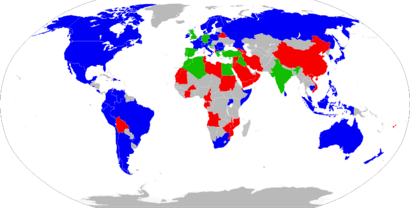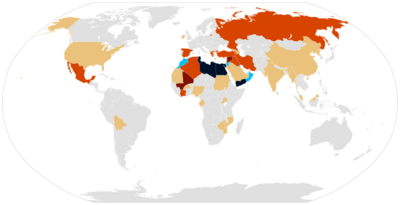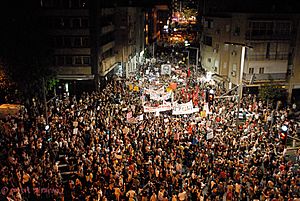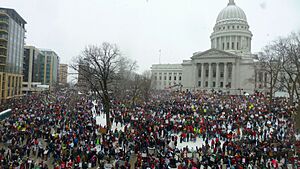Impact of the Arab Spring facts for kids
Quick facts for kids Impact of the Arab Spring |
|
|---|---|
| Part of International reactions to the Arab Spring | |

Locations of global protests in 2011. Blue refers to Occupy movement protests, red refers to Arab spring and later protests, and green refers to protests inspired by the Arab Spring outside the Occupy movement.
|
|
| Date | Early 2011–2012 |
| Location |
Worldwide outside the Arab countries
|
| Caused by | Arab Spring |
The impact of the Arab Spring refers to protests and movements around the world. These events were inspired by or similar to the Arab Spring. The Arab Spring was a series of protests in countries like Egypt and Tunisia.
Many people, organizers, and experts saw these protests as connected. They happened in countries outside the Arab-majority states of North Africa and the Middle East. These demonstrations often criticized their governments. Some protests asked for small policy changes. Others aimed to completely change the political system.
In some places, protests grew very large. They even led to big changes at the national level, like in Armenia. In other countries, like Djibouti, protests were quickly stopped. Protests inspired by the Arab Spring happened on every continent where people live. Their success and fame varied greatly. For example, on October 15, 2011, the "Occupy" and "Indignants" movements led to protests in 950 cities across 82 countries.
Contents
What Inspired Protests Around the World?
Many protests happened globally around the same time as the Arab Spring. People often said these protests were inspired by events in the Arab world. These events started in late 2010. This created a network where ideas for protests spread quickly.
Some countries that had not yet seen protests took steps to prevent them. They wanted to avoid similar events. Other countries faced political problems because of how their governments reacted to news from abroad.
Protests in Africa
Djibouti: Calls for Change
On February 2, people in Djibouti City started peaceful protests. About 300 people asked President Ismail Omar Guelleh not to run for another term. They also wanted more freedom and reforms. Soon, thousands joined the protests. Many promised to stay until their demands were met.
On February 18, about 30,000 people protested. They said the change allowing the president a third term was illegal. The protest turned violent with police clashes. At least two people died, and many were hurt. Police used live ammunition and tear gas. Protest leaders were arrested, and the movement lost its energy. The last planned protest on March 11 was stopped by security forces.
Ivory Coast: Women Lead Protests
In Côte d'Ivoire (Ivory Coast), peace activist Aya Virginie Toure organized thousands of women. They held many peaceful protests across the country. Security forces met them with tanks and opened fire. Toure spoke on BBC News, comparing the Second Ivorian Civil War to the 2011 Libyan civil war. She asked for international help to remove Laurent Gbagbo from power.
Some officials criticized the international community. They noted that a no-fly zone was imposed over Libya, but less action was taken in Ivory Coast. This was partly because oil in Libya was seen as more important than cocoa in Ivory Coast.
Mali: A Rebellion's Link to Libya
A Tuareg rebellion began in early 2012. It forced Mali's armed forces to retreat. The National Movement for the Liberation of Azawad (MNLA) claimed a large area as the Tuareg homeland. This conflict worsened with a military coup in Mali. President Amadou Toumani Toure was forced out of power.
The MNLA declared Azawad an independent state on April 6, 2012. Media outlets like The Wall Street Journal linked this to the Arab Spring. However, some groups, like Ansar Dine, wanted strict Islamic law across Mali. The international community did not recognize Azawad's independence.
This rebellion and coup were seen as "fallout" from the Arab Spring. The Tuareg rebellion succeeded partly because fighters brought heavy weapons from Libya. They had fought on both sides of the 2011 Libyan Civil War in 2011.
Uganda: Protests Over Prices
Ugandan President Yoweri Museveni won the 2011 Ugandan general election on February 11. The opposition called the results unfair. Opposition leader Kizza Besigye warned that Uganda could see an Egypt-style revolt. This was after Museveni had been in power for over two decades.
Protesters did not gather in huge numbers. The government disrupted their efforts to count votes. Hundreds of opposition workers were arrested. As food and fuel prices rose, unrest grew. Kizza Besigye's arrest on April 28 sparked protests and riots in Kampala. Two people died in these events.
Zimbabwe: Discussing Uprisings
Munyaradzi Gwisai, a former politician, organized a meeting. They discussed the uprisings in North Africa on February 21. He and 45 others were arrested. They were reportedly tortured and faced treason charges, which could mean the death penalty. Many Zimbabweans living in South Africa openly discussed these events.
A "Million Citizen March" was planned for March 1 in Harare. But it did not happen. Police had a heavy presence since February 26, and a curfew was declared.
Protests in Europe
Greece: Inspired by the Arab Spring
From 2010 to 2012, Greece saw many demonstrations and strikes. These protests were inspired by the Arab Spring. People protested across Greece against government policies.
Russia: Warnings of an "Arab Spring"
In March 2012, politician Sergei Mironov warned about Russia. He said if the next president did not make big reforms, Russia could face an "Arab Spring" within two years. Telegraph suggested he might be trying to scare people.
Mikhail Khodorkovsky, an imprisoned businessman, also linked Russian protests to the Arab Spring. He said, "We have only to reflect on the events in countries swept up in the Arab Spring to recognise the transformation taking place in the compact between the rulers and the ruled." He noted similarities between Russia and those countries.
Turkey: Gezi Park Protests
In 2013, people in Turkey started a silent protest at Gezi Park. They were against a plan to demolish the park. Police action against them sparked bigger anti-government protests. Many different groups joined these protests.
Ukraine: The "Ukrainian Spring"
The term "Ukrainian Spring" is sometimes used. It refers to events in Ukraine that had similar causes to the Arab Spring. These included strong government control, widespread corruption, and lack of opportunities.
United Kingdom: Anti-Austerity and Riots
The 2011 United Kingdom anti-austerity protests and 2011 England riots also occurred. These events showed public discontent in the UK.
Protests in Asia
Armenia: Merchants and Political Rallies
Unrest reached Armenia in January. Merchants protested a ban on street trading in Yerevan. They marched and demanded the ban be lifted. The Armenian National Congress then organized larger political rallies in Yerevan. These rallies drew tens of thousands of people.
Protesters demanded the release of political prisoners. They also wanted social and economic reforms. The government made some big changes. They agreed to investigate deaths from 2008 protests. They also opened Freedom Square for rallies and released some jailed activists. President Serzh Sargsyan said his government wanted to work with the opposition.
Azerbaijan: Crackdowns on Protests
Young activists and opposition leaders called for protests in March. They were inspired by the Arab Spring. The government responded with crackdowns and many arrests. Reuters reported at least 150 activists were arrested in March. Police arrested nearly 300 more in April, including journalists. Dozens more were arrested in May.
China: Food Prices and "Jasmine Revolution"
China played an unexpected role in the Arab Spring. A winter wheat crop failure and a huge drought in January 2011 led China to buy wheat internationally. This doubled prices, causing unrest in Egypt. Egypt relies heavily on imported wheat. These food riots weakened the government and helped start civil unrest in Egypt.
Calls for a "Jasmine Revolution" in China spread on social media. Chinese authorities arrested activists and increased police presence. They also blocked some cell phone services and deleted internet posts about planned protests. On protest days, police were everywhere. Small crowds gathered but did not chant slogans. Chinese leaders called for tighter internet controls to prevent instability.
Premier Wen Jiabao promised to control rising prices and corruption. This was seen as an effort to prevent protests. He also promised to boost food supplies.
Tibetan Government-in-Exile: A Leader Steps Down
In March 2011, the 14th Dalai Lama Tenzin Gyatso announced he would step down from his political role. He was the leader of the Tibetan government-in-exile. This paved the way for a new prime minister to be elected. He called the rule of Tibetan Buddhist spiritual leaders "outdated." He added, "I do not want to be like Mubarak." Lobsang Sangay was elected the new prime minister.
Iran: Green Movement Returns
On February 9, Iranian opposition groups asked to protest. The government refused permission. Despite this, leaders like Mir Hossein Mousavi and Mehdi Karroubi called for protests on February 14.
Rumors suggested students, drivers, and merchants would join. They were part of the Green movement. This movement was inspired by events in Egypt and Tunisia. The Islamic Revolutionary Guard Corps warned they would stop protesters. Many activists were arrested before the demonstrations.
Thousands to hundreds of thousands of protesters gathered. Clashes happened between protesters and security forces in Tehran. Police used tear gas and batons to break up crowds. Protesters set fires in garbage bins. Clashes were also reported in Isfahan.
Israel: Housing Protests
The 2011 Israeli housing protests started on July 14, 2011. They were a series of street demonstrations across Israel. On September 3, 2011, the largest protest ever in Israel took place. About 460,000 people protested nationwide, with 300,000 in Tel Aviv alone.
The protests began when a Facebook group led hundreds to camp in tents in Tel Aviv. The movement grew quickly. It sparked discussions about the high cost of housing and living expenses. Protesters set up tents in central streets in many cities in Israel. They were against rising housing prices, especially in major cities.
Media and studies suggested these protests were inspired by the Arab Spring. The Israeli protests were generally peaceful.
Maldives: Protests and Resignation
On May 1, 2011, thousands protested in Male. They demanded President Mohamed Nasheed step down. Police broke up the protests. Dozens were hurt, and many arrested. Protests continued the next day. The main reasons were high food prices and unemployment. The main opposition party said "currency devaluation has increased the price of essentials." Protests continued for a week, then calmed down.
Protests started again later that year. This led to the president's resignation in February 2012. Some experts and diplomats debate if this was a coup.
North Korea: Leaflets and Censorship
The South Korean military dropped leaflets into North Korea. These leaflets had information about protests in Egypt and Libya. This was an attempt to encourage political change in North Korea.
North Korea threatened military action if South Korea continued. The Korean Central News Agency reported this. South Korean media reported small protests in North Korea. North Korea responded by censoring all news of the Arab Spring. They banned public demonstrations. They also placed tanks in Kim Il-sung Square, Pyongyang.
Protests in the Americas
United States: Wisconsin and Occupy Wall Street
A series of demonstrations began in the United States on February 14, 2011. Tens of thousands of protestors, including union members and students, participated. The protests focused on collective bargaining laws. They mainly took place around the Wisconsin State Capitol in Madison, Wisconsin. Smaller protests happened in other cities and at universities. They also spread to Columbus, Ohio.
These protests were seen as inspired by the 2011 Egyptian revolution. Linguist Noam Chomsky said the Wisconsin protests and the Egyptian revolution were "closely intertwined." Both involved "struggles for labor rights and democracy." Some protesters in Wisconsin and Ohio carried Egyptian flags.
On September 17, 2011, "Occupy Wall Street" protests began in New York City's financial district. These protests responded to government bailouts for banks. They also highlighted growing income inequality. This movement became known as the "Occupy" movement. It spread to cities across the United States and worldwide.
Censorship and Preemptive Actions
Ethiopia: Price Caps and Warnings
After Tunisia's president fled, the Ethiopian government set a cap on essential food prices. Journalist Eskinder Nega was warned after writing about events in Egypt. He was later jailed for criticizing human rights abuses.
Kazakhstan: Avoiding Unrest
On January 31, 2011, Kazakhstan's President Nursultan Nazarbayev canceled a 2011 Kazakhstani presidential term referendum. This referendum would have kept him in power for decades. He called an early election for April 3, 2011. He also offered citizens discounted shares in national companies. Critics said this was to distract from claims that wealth was controlled by a "corrupt elite."
Turkmenistan: Worries and Censorship
Some experts believed conditions in Turkmenistan were similar to countries with protests. The government of President Gurbanguly Berdimuhamedov seemed worried. His regime censored all news of the protests. There were reports that authorities tracked citizens abroad. They warned some they might not be allowed to return or leave again.
Uzbekistan: Reforms to Prevent Upheaval
The Uzbekistani government made parliamentary reforms in March. The Legislative Chamber gained more power. It could now challenge the prime minister. Both houses of the Supreme Assembly could also "demand information" from the executive branch. An analyst said these reforms were inspired by recent revolutions. They aimed to prevent popular unrest through democracy and accountability.
See also
- 15 October 2011 global protests
- 2011 Wisconsin protests
- Civil resistance
- Freedom in the World
- 2009 Icelandic financial crisis protests
- 2010–12 Greek protests
- 2011–12 Spanish protests
- 2011 United Kingdom anti-austerity protests
- Occupy Wall Street
- Occupy movement
- Protests of 1968
- Revolutionary wave
- Internet outage
- Internet manipulation




